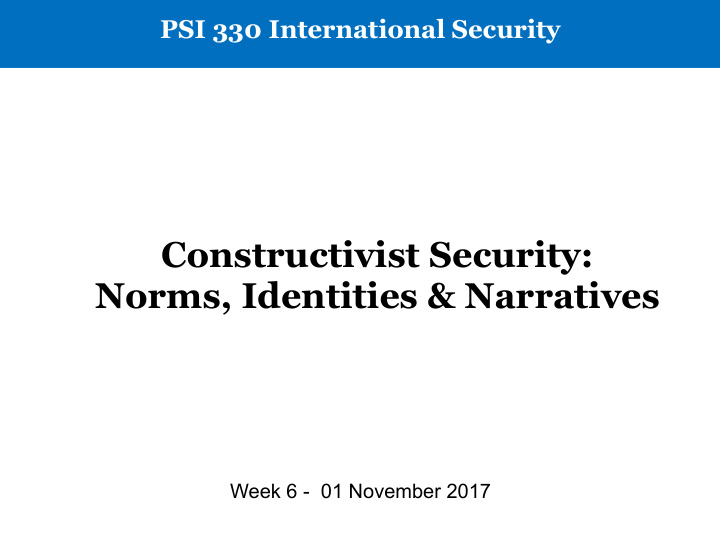



PSI 330 International Security Constructivist Security: Norms, Identities & Narratives Week 6 - 01 November 2017
The Critique of Positivist Approaches • Structural Realism • Balance of Power • Balance of Threats • Neoliberalism • Democratic Peace • Institutions
Constructivist Approach • In essence, the constructivist “critique of neorealists and neoliberals concerns not what these scholars do and say but what they ignore: the content and source of state interests and social fabric of world politics.” Constructivism (I) Culturalism Constructivism (II) Conventional Critical
Constructivism (I) vs Culturalism Constructivism (I) Culturalism Focus on the International level. Focus on the domestic level. States do what they think most Strategic culture and organizational appropriate. culture determines state behavior. How strategic and organizational The normative bases of interstate culture shapes military actors and conflict and state use of violence. action. See international norms shaping The impact of domestic norms on similarity in state form and action, state form and action, they invariably regardless of the material find norms producing difference in circumstances of states what states do. Constructivism and culturalism locate actors in a social structure that both constitutes those actors and is constituted by their interaction.
Constructivism (I) vs Culturalism • Difference in the Level of Analysis causes contradictory predictions between Constructivist and Culturalist • For example: Force postures of nuclear states • Constructing a unified research agenda: • Constructivist -> Looking inside • Culturalist -> Looking outside
Conventional vs Critical Conventional Critical Social theory is a weapon for waging Analytically neutral between conflict war on inequality and injustice in and cooperation. world politics Ignore actor-observer connection, The actor and observer can never be focus on interpretation separated Both conventional and critical aim to “denaturalize” the social world
Core Concepts • Ideas: • Not merely rules or “road maps” but operate “all the way down” • Norms: • Intersubjective beliefs about the social and natural world • Identity: • Relatively stable, role-specific understandings and expectations about self. • Culture: • Both to a set of evaluative standards and to cognitive standards
Methodological Problems • Proving the Existence of Norms • Constructivists recognize norms as having objective existence • Beliefs must be expressed, if not codified and recorded, to be shared • For example:
Methodological Problems • Showing the Impact of Norms on Behavioral Outcomes • “Because multiple norms can influence actors—with competing or even contradictory prescriptions for behavior and for identity—it is difficult to predict which norms will be most influential.” (Kowert and Legro) • Solutions: 1. Process-tracing method 2. Historical observation
Casual Pathways to Explain National Security Agenda 1. Effects of Norms (1): Cultural or institutional elements of states’ environments shape the national security interests or (directly) the security policies of states 2. Effects of Norms (2): Cultural or institutional elements of states’ global or domestic environments shape state identity 3. Effects of Identity (1): Variation in state identity, or changes in state identity, affect the national security interests or policies of states 4. Effects of Identity (2): Configurations of state identity affect interstate normative structures, such as regimes or security communities 5. Recursivity: State policies both reproduce and reconstruct cultural and institutional structure.
Casual Pathways to Explain National Security Agenda 4 Environmental Structure 2 Identity 3 3 1 Interests 1 5 3 Policy
Anarchy Anarchy is what states make of it Anarchy Self-help & Power Politics Continuum of security Competitive Security Individualist Security Cooperative Security System System System • Negative Identification • Indifferent to others • Positive Identification security • Relative gains • National interests are • Absolute gains International interests
Anarchy INSTITUTIONS PROCESS (1) Stimulus requiring action State A with identities and interests (2) State A’s definition of the situation Intersubjective (3) State A’s action understandings and expectations possessed by and constitutive of A & B (4) State B’s interpretation of A’s action and B’s own definition of the situation State B with identities (5) State B’s action and interests
Anarchy
Security Dilemma “the security dilemma is an important dynamic in conflictual interstate relationships, it is irrelevant for many pairs and groups of states that enjoy nonconflictual relations.” (Hopf) The Dilemma of Interpretation The Dilemma of Response Defensive or self- Signal protection Reassurance State A increases military capabilities Offensive React in kind State B
Democratic Peace • Two Problems: 1. Liberal democracies are just as war-prone as other types of states when it comes to fighting non-liberal democracies 2. Liberal democracies occasionally appear to have gone to war with each other • the liberal-democratic peace is the absence of war between states that perceive themselves and each other to be liberal democracies • Also: “Authoritarian Peace” in Africa and Latin America
International Institutions How states understand their interests within a particular issue area? Distribution of Possibility of Cooperation Identity and Interests
Military Organizations Why do developing states emulate great power’s military organizations? Occurs during peace-time Occur at times because, familiarity of great need - in particular after defeat Why do states procure sophisticated weapon systems? These are what constitutes a They need it modern military
Conclusion • Fundamental Questions of Security: 1. What is Security? 2. Whose Security? 3. What are the Primary threats? 4. How can security be achieved?
Recommend
More recommend